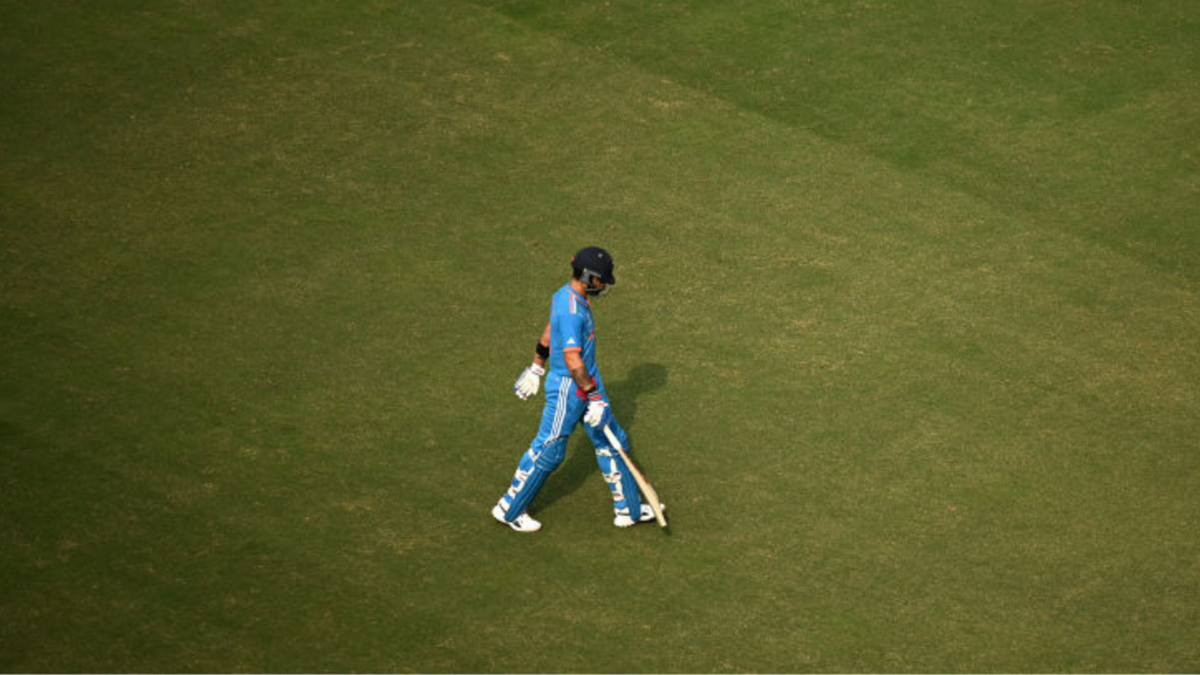
Virat Kohli made his first ever World Cup duck, against England in Lucknow today (October 29). The story of what transpired before his dismissal is that of genius planning and execution by the England bowlers and fielders.
To bet on the World Cup with our Match Centre Partners bet365 head here.
The third over of India’s innings, bowled by David Willey fetched 18 runs. Rohit Sharma, in his typically dismissive avatar, smashed two sixes and a four in the over, not moving away from his template despite batting first in the tournament for the first time.
Chris Woakes then got a full ball to seam back in on the last delivery of the fourth over to dismiss Shubman Gill. What followed for the next three overs was a work of art by the English team on the field.
Rohit took a single off the second ball of the fifth over to get Kohli on strike for the first time in the match. Willey, who has partnered Kohli in the IPL for the last two seasons, was right on the money with his line and length. His first ball to Kohli was on the stumps, attempting to shape it back into him. With not much assistance available in the air, Willey adjusted quickly.
Almost every other ball he bowled to Kohli was on a good length on the fourth stump channel, angling away from him. To the second ball, Kohli pressed forward like he usually does, but the nip in the Lucknow surface meant that the ball beat his poking bat. He then defended the last two balls of that over.
Woakes then bowled a maiden at Rohit. To bowl a maiden at Rohit inside the powerplay, when he is looking to dismiss balls from his presence as if he hates them to his core and doesn’t want them lurking anywhere near him, you have to keep it tight and get the ball to move. Woakes did both.
Away-swing, seam movement back in, wide release, Woakes pulled out his bag of tricks and even got Rohit to edge one that fell short of slip.
Suddenly, India had gone from 26-0 after 3.5 overs to 27-1 from six. The last 13 balls had fetched just one run. India had scored at 6.28 inside the first ten overs in this World Cup before this game, second only behind Australia. This was unfamiliar territory for them.
And it showed as Kohli stepped out to force the issue on the first ball of the seventh over, but Willey didn’t budge. He marginally shortened his length keeping the line the same as Kohli’s punch found the cover fielder. The next ball was too good for Kohli to try anything. Blocked.
The first six balls Kohli faced had fetched no run. India’s last 15 had fetched one. When Kohli timed his cover drive on the next ball to perfection, on the rise no less, both he and India would have felt the shackles were about to break and Kohli was about to get going.
That was until Dawid Malan leapt to his left at short cover to pull off a one-handed stop. Kohli played out the next ball to point for no run again.
And Nasser Hussain pointed out that the stop made by the fielder a ball or two prior to the dismissal (the cover drive I think) was so crucial. It forced Virat Kohli to play this shot and led to his downfall today. Good cricket. https://t.co/GPloWiira1
— Jay (@bhavsarJ2_0) October 29, 2023
Kohli has self-admittedly been a batter who has stuck to his technique no matter the format or the situation. However, eight balls without scoring a run inside the powerplay when the team template has been to go hard early on, especially against the very team that brought about this revolution in the ODI game, was too much for even Kohli.
Having been unable to find gaps along the ground, Kohli stepped out and tried to go aerial over mid-off. Willey smartly pulled his length back but Kohli had committed. He went through with his hoick, only managing to splice it to Ben Stokes at mid-off instead.
England’s brilliant planning and execution had just forced Kohli into his longest duck in ODIs and his first-ever in white-ball World Cups.








